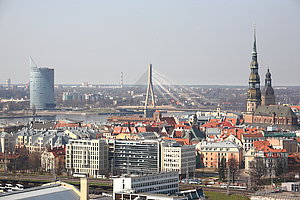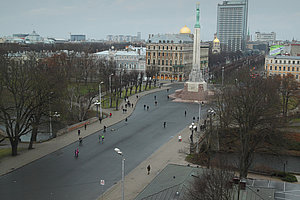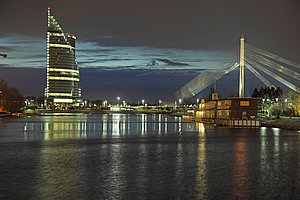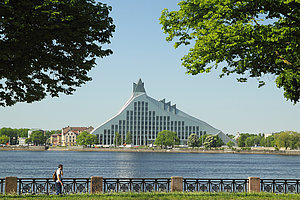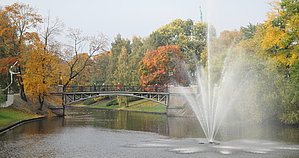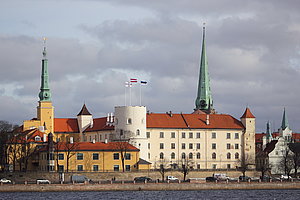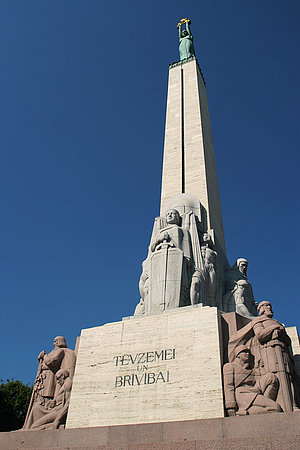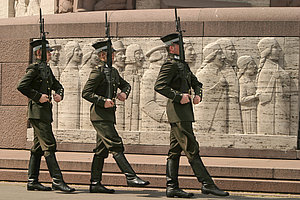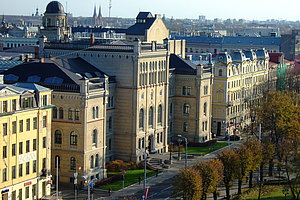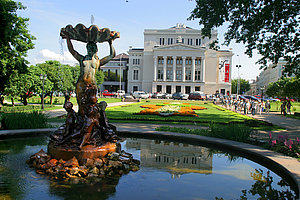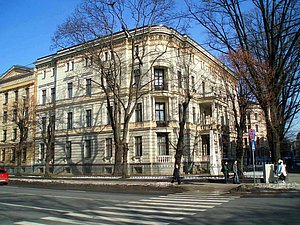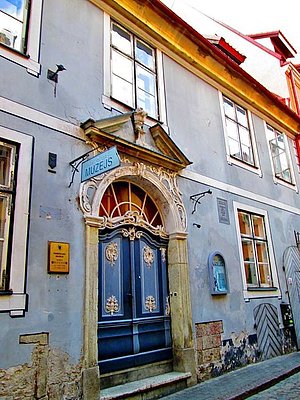ABOUT RĪGA
Latvia is snuggled in the middle of the Baltics between Lithuania and Estonia.
A legend has it that Riga, - a city full of cultural and historic attractions, will "never be complete, and will be (for)ever changing and developing."
Heritage of 800 years old Gothic churches, built by founders of Riga, medieval buildings in the Old Town, exquisite Art Nouveau, as well as wooden buildings make Riga a true pearl of architecture.
© Foto: Toms Grīnbergs, LU Komunikācijas un inovāciju departaments
Riga city centre is a UNESCO World Heritage Site and known for its beautiful Jugendstil (Art Nouveau) architecture.
Alberta Street

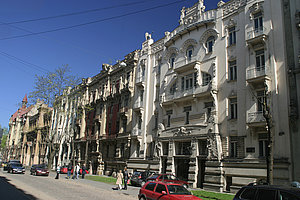
© Foto: Toms Grīnbergs, LU Komunikācijas un inovāciju departaments
Alberta Street is regarded as Riga’s Art Nouveau gem, since it is full of splendid historical Art Nouveau-style buildings from one end to the other. The area was erected in a short period of time – from 1901 to 1908, each of the buildings standing alone as an inimitable 20th century architectural achievement. Eight buildings are now recognised as architectural monuments of national significance. Named after the founder of Rīga, Bishop Albert von Buxthoeven, the street was the architect's gift to Rīga on its 700th anniversary. Alberta iela is a must-see Rīga sight with residential houses, restaurants and shops. Jugendstil is the style and the master responsible for most of the houses is Mikhail Eisenstein (father of filmmaker Sergei Eisenstein).
Freedom Monument
© Foto: Toms Grīnbergs, LU Komunikācijas un inovāciju departaments
Affectionately known as 'Milda', Rīga's Freedom Monument towers above the city between Old and Central Rīga. Paid for by public donations, the monument was designed by Kārlis Zāle and erected in 1935 where a statue of Russian ruler Peter the Great once stood. At the base of the monument there is an inscription that reads 'Tēvzemei un Brīvībai' (For Fatherland and Freedom), accompanied by granite friezes of Latvians singing and fighting for their freedom. Among the figurines, you may recognise that of Lāčplēsis - the half-man, half-bear who symbolises Latvians' struggle for independence. A copper female Liberty tops the soaring monument, holding three gold stars in her hands. The three stars represent the three original cultural regions of Latvia: Kurzeme, Vidzeme and Latgale. Two soldiers stand guard at the monument throughout the day and perform a modest changing of the guards every hour on the hour from 9am to 6pm.University of Latvia
© Foto: Toms Grīnbergs, LU Komunikācijas un inovāciju departaments
The University of Latvia (Latvijas Universitate) was designed by the architect Gustav Hilbig and built in 1866. Established in 1919, the University has graduated most of Latvia's leaders and important political, scientific, and cultural heroes. With almost 30,000 students, the university is the premier institution of higher education in Riga. Address: 19 Raina boulevardLatvian National Opera
© Foto: Toms Grīnbergs, LU Komunikācijas un inovāciju departaments
Riga's White House — the Latvian National Opera and Ballet on Aspazijas bulvāris was opened in 1923. An average of six new productions are presented each year, retaining balance between opera and ballet. In total, the opera sees over 200 performances and several symphonic and chamber music concerts a season. In the 1990s, the opera house underwent large-scale reconstruction and restoration of the interior, highlighting the original decorations and matching the new interior of premises to them. The construction was finished in 2001, when new complex building for technical and creative staff and the New Hall with 300 seats for realisation of wide range art projects were finished. Address: 3 Aspazijas boulevard Website: www.opera.lv/enThe Old Town
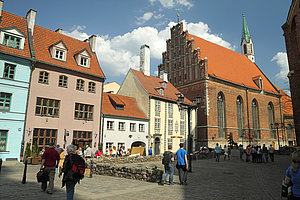

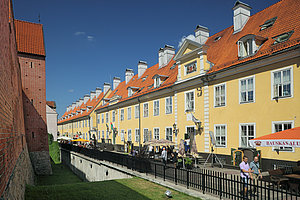
© Foto: Toms Grīnbergs, LU Komunikācijas un inovāciju departaments
The Old Town is the oldest section of Riga as well as the center of the city, and with its narrow cobble-stone streets not only features gorgeous Medieval-era buildings, but unique sacral structures as well. It is the city’s most popular area with tourists. In 1997, Riga's historic center was included in the UNESCO World Heritage List. The Old Town has highly diverse architecture, and the majority of buildings have the status of a cultural monument. The city's architecture represents various periods - Romanticism, Gothic, Baroque, Classicism, and Modernism. After the restoration of the independence of Latvia, many buildings in the Old Town were reconstructed or rebuilt to restore the historic look of the area. The most impressive buildings in the Old Town are the Riga Cathedral and St. Peter's Church, offering a wonderful panoramic view on the city of Riga from a 72 meter observational tower.House of the Blackheads
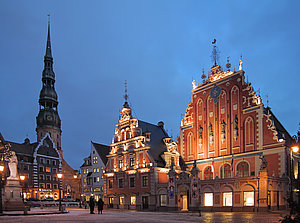
© Foto: Toms Grīnbergs, LU Komunikācijas un inovāciju departaments
Towards the end of the 14th century, the guilds uniting Riga’s merchants and craftsmen were joined by a brotherhood of banquet caterers to upper classes which quite significantly called themselves Blackheads. Its members included young and unmarried merchants of foreign, mostly German, descent. When traveling and supplying exotic goods from overseas, they managed to protect their ships and caravans from pirates and robbers. The Blackheads chose St. Maurice as their patron saint, who traditionally was depicted as a black soldier in knight’s armor. After obtaining their tenant’s rights and entering holy wedlock, members of the brotherhood become part of Riga’s patrician elite, serving as councilors, members of the Great Guild and respected members of the city’s community. The 17th century merchant organization, the Brotherhood of the Blackheads, became the sole tenant of the House of the Blackheads. Built in 1344 as a veritable fraternity house for the Blackheads guild of unmarried German merchants, the original house was decimated in 1941. Somehow the original blueprints survived and an exact replica of this fantastically ornate structure was completed in 2001 for Rīga’s 800th birthday. Address: 7 Ratslaukums
Riga Cathedral
© Foto: Toms Grīnbergs, LU Komunikācijas un inovāciju departaments
Founded in 1211 as the seat of the Rīga diocese, the enormous (once Catholic, now Evangelical Lutheran) Riga Сathedral is the largest medieval church in the Baltic. The architecture is an amalgam of styles from the 13th to the 18th centuries: the eastern end, the oldest portion, has Romanesque features; the tower is 18th-century baroque; and much of the rest dates from a 15th-century Gothic rebuilding. The building, along with its huge 6768-pipe organ, built in 1884, underwent a careful reconstruction. It was used as a classical-music venue, which it very much remains now, although services have been resumed since the Lutheran archbishop of Latvia moved in. Address: 2 Palasta Street
The Pauls Stradins Museum of The History of Medicine
The Pauls Stradins Museum of the history of medicine is one of the three biggest museums for history of medicine in the world. The purpose of the museum is to encourage public interest in the development of medicine from antiquity to the present day, also helping people to understand the close linkage which exists between history and medicine. The museum is one of the three largest museums of its type in the world. The museum receives 40,000 visitors annually. The Museum collection is comprised of more than 199,000 objects. Thematic exhibits regarding subjects of current interest to society are organized each year. The Museum's core exhibition is housed on four floors, arranged in chronological order. The exhibits relate the story of medical development. Pauls Stradins himself was interested in presenting this information. Address: 1 Antonijas Street Website: http://www.mvm.lv/en
Pharmacy Museum

 LU konference
LU konference